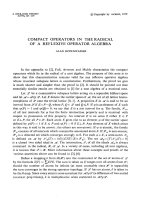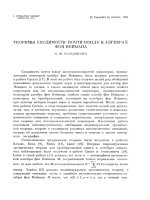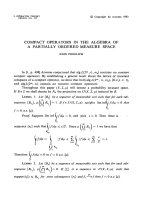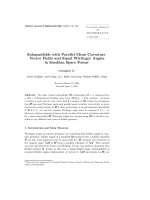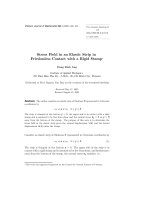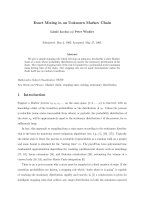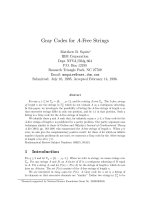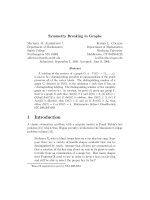Báo cáo toán học: "Perfect codes in Cartesian products of 2-paths and infinite paths" pptx
Bạn đang xem bản rút gọn của tài liệu. Xem và tải ngay bản đầy đủ của tài liệu tại đây (112.08 KB, 9 trang )
Perfect codes in Cartesian products of 2-paths
and infinite paths
Paul Dorbec
∗
, Michel Mollard
†‡
ERT´e Maths `a Modeler, Groupe de recherche G´eoD,
Laboratoire Leibniz ,
46 av. F´elix Viallet, 38031 Grenoble CEDEX, FRANCE
Submitted: Feb 24, 2005; Accepted: Nov 22, 2005; Published: Nov 29, 2005
Mathematics Subject Classifications: 05C69,05C70,94B60
Abstract
We introduce and study a common generalization of 1-error binary perfect codes
and perfect single error correcting codes in Lee metric, namely perfect codes on
products of paths of length 2 and of infinite length. Both existence and nonexistence
results are given.
1 Introduction
Perfect codes appeared in error correcting codes theory during the late 40’s with the
work of Golay and Hamming [3, 6]. They constructed perfect binary single-error correcting
codes of length n where n =2
q
− 1 for some integer q.
Later, Golomb and Welch [4, 5] proved, for any length n, the existence of perfect
single-error correcting codes in Lee metric. Such codes can be considered either as regular
periodic tilings of the euclidean space R
n
by Lee spheres of radius 1 or as periodic tilings
of the grid Z
n
by balls of radius 1. Perfect codes have also been studied on other alphabets
or mixed one (see [2]).
In [1], Biggs introduced perfect codes in graphs. From this point of view, a perfect
binary single-error correcting code of length k is a perfect code on the hypercube Q
k
,and
a tiling of the grid Z
n
by balls of radius 1 is nothing more than a perfect code of Z
n
.
∗
ENS Lyon,
†
CNRS,
‡
This work was partially supported by PROTEUS
the electronic journal of combinatorics 12 (2005), #R65 1
Both Q
k
and the grid Z
n
are cartesian products of paths either of length 2 (P
2
)or
of infinite length (P
∞
). We study the existence of perfect codes on the mixed product
P
n
∞
P
k
2
= Z
n
Q
k
.
In the next section, we give the definitions we will use along this paper. Section 3
presents classical results on error correcting codes. In section 4, we construct new codes,
and in section 5, we prove some inexistence results. The last section summarizes what we
know and what is still open.
2 Definitions
Given G
1
=(V
1
,E
1
)andG
2
=(V
2
,E
2
) two graphs, the cartesian product G
1
G
2
is
the graph with vertex set V
1
× V
2
and satisfying (x
1
,x
2
)(y
1
,y
2
) ∈ E(G
1
G
2
)ifandonly
if x
1
y
1
∈ E
1
and x
2
= y
2
or x
2
y
2
∈ E
2
and x
1
= y
1
. We will use the notation G
n
for the
graph G
G G (n times).
The hypercube of dimension k is the graph Q
k
whose vertices are the words of length k
over the alphabet {0, 1}, and where two vertices are adjacent if they differ in exactly one
place. Notice that Q
1
is P
2
the path with 2 vertices and that Q
k+1
= Q
k
P
2
.Fortwo
vertices u and v in Q
k
, we will denote by u+v the vertex ((u
1
+v
1
), (u
2
+v
2
), ,(u
k
+v
k
))
where + is the sum modulo 2.
The infinite grid Z
n
is the graph whose vertices are the words of length n over the
alphabet Z and where two vertices are adjacent if and only if they differ by 1 in exactly one
place. Notice that if we denote by P
∞
the two ways infinite path, we have also Z
1
= P
∞
and Z
n+1
= Z
n
P
∞
.
We will consider in the same idea the vertices of the cycle of length l, denoted by C
l
,
as the elements of Z/lZ. For two vertices u and v, we will denote by u + v the vertex
(u + v)modl.
From now on, we will work on the cartesian product Z
n
Q
k
. This graph can also be
considered as follows : the vertices are words of length n + k whose n first symbols are in
Z and the k others are in {0, 1}. Two vertices are adjacent if they differ by 1 in exactly
one place. Notice that this graph is regular with degree 2n + k.Moreover,Z
n
Q
0
= Z
n
and Z
0
Q
k
= Q
k
.
For two vertices x and y, we will denote by d(x, y) the classical distance on graphs.
For our graph Z
n
Q
k
,
d((x
1
,x
2
, ,x
n+k
), (y
1
,y
2
, ,y
n+k
)) =
n+k
i=1
|x
i
− y
i
|
If n = 0, this is the Hamming distance,andifk = 0, this is the Manhattan distance.
For an integer r and a vertex c,wecallbal l of radius r centered on c the set of vertices
v such that d(c, v) ≤ r. In this paper, we will only consider balls of radius 1.
In a graph, a single error correcting code (or code for shorter) is a set of vertices such
that any two code’s vertices are at distance at least 3. This is equivalent to say that the
balls centered on these vertices are disjoint.
the electronic journal of combinatorics 12 (2005), #R65 2
Figure 1: A perfect code on Z
1
Q
1
?
Figure 2: There exists no perfect code on Z
1
Q
2
Acodeissaidtobeperfect if any vertex of the graph is at distance at most one of a
code’s vertex. It also means that any vertex belongs to a ball centered on a code’s vertex
and thus that these balls form a tiling of the graph.
Figure 1 shows a perfect code in Z
1
Q
1
. But a perfect code does not always exists as
figure 2 shows.
Let G be a finite graph. On Z
n
G, we will say that a code is i-periodic (i ∈{1, ,n})
if there exists a positive integer p
i
such that for any vertex x =(x
1
,x
2
, ,x
n
,v)(where
∀i, x
i
∈ Z, v ∈ V (G)), the vertex (x
1
,x
2
, ,x
i−1
, (x
i
+ p
i
),x
i+1
, ,x
n
,v) is in the code
if and only if x is in the code. p
i
is called the i-period. A code is periodic of period
(p
1
,p
2
, ,p
n
)ifitisi-periodic of i-period p
i
for all i.
Proposition 1 Let S be a periodic code on Z
n
G of period (p
1
,p
2
, ,p
n
). There exists
some set T of words t =(t
1
,t
2
, ,t
n
,v) with ∀i ∈{1 ,n}, 0 ≤ t
i
<p
i
and v ∈ V (G)
such that S is the set of words
{(t
1
+ α
1
p
1
,t
2
+ α
2
p
2
, ,t
n
+ α
n
p
n
,v)|t ∈ T,α
i
∈ Z}
3 Perfect codes deduced from known
constructions
From the classical results on error correcting codes, we get:
Theorem 2 If n =0, there exists a perfect code on Z
n
Q
k
if and only if there exists an
integer p such that k =2
p
− 1.
Examples of these perfect codes are the classical Hamming codes [6], but when k ≥ 15,
other perfect codes with the same length are known (for a survey on this topic, see [2]).
Theorem 3 There exists a i-periodic perfect code on Z
n
G of i-period p
i
if and only if
a perfect code on the graph Z
n−1
C
p
i
G exists.
Proof : Let S be a perfect code on Z
n−1
C
p
i
G. Then one can easily check that the set
of words
{(x
1
,x
2
, ,x
n−1
,c+ αp
i
,v)|(x
1
,x
2
, ,x
n−1
,c,v) ∈ S, α ∈ Z}
the electronic journal of combinatorics 12 (2005), #R65 3
layer x = 1
3
layer x = 0
3
Figure 3: A perfect code on Z
2
Q
1
is a perfect code of Z
n
G.
On the other hand, let us consider a perfect i-periodic code S on Z
n
G of i-period p
i
.
Without loss of generality, we can suppose that i = n. The set of words
{(x
1
,x
2
, ,x
n
,v)|(x
1
,x
2
, ,x
n
,v) ∈ S, 0 ≤ x
n
<p
n
}
is a perfect code on Z
n−1
C
p
n
G.
Thus, there exists a periodic perfect code on the grid Z
n
of period (p
1
, ,p
n
)ifand
only if a perfect code on the graph C
p
1
C
p
n
exists.
In 1968, Golomb and Welch [4] proved the existence in Lee metric of perfect one error
correcting codes for any word length n over an alphabet of 2n + 1 elements. This is a
perfect code on the graph C
n
2n+1
, and this implies the following well known result.
Theorem 4 If k =0, for any n ∈ N, there exists a periodic perfect code on Z
n
Q
k
.
4 Constructing perfect codes
A perfect code on Z
2
Q
1
exists (see figure 3). We can consider this construction as a
tiling of Z
2
with balls of radius 1 and of radius 0. The set of balls of radius 1 is obtain
from the set of balls of radius 0 by a translation. With this approach, such a tiling can
be generalized for any n on Z
n
Q
1
.
But it is a special case of a more general construction we present hereby.
Theorem 5 There exists a perfect code on Z
n
Q
k
whenever there are some α, β ∈ N
∗
such that k =2
α
− 1 and n = β2
α−1
.
Proof : Let k =2
α
− 1andn = β2
α−1
. We will construct a perfect code on Z
n
Q
k
.
From theorem 2, there exists a perfect code A
0
on Q
k
.Wedenotebye
1
, ,e
k
the k
vertices of Q
k
at distance 1 of (0, ,0) and by A
i
the set {c + e
i
|c ∈ A
0
}. By definition
of a perfect code, any A
i
is also a perfect code on Q
k
and A
0
,A
1
, ,A
k
is a partition of
V (Q
k
). To prove the theorem, we will construct a mapping from Z
n
that characterizes a
perfect code on Z
n
Q
k
.Denotebyx =(x
1
,x
2
, ,x
n
)anelementofZ
n
.
the electronic journal of combinatorics 12 (2005), #R65 4
THE CASE β EVEN:
Let β =2p.Wehaven = p(k +1).
We define the following mapping from Z
p(k+1)
to Z/(k + 1)(2p +1)Z:
f(x)=
k
i=0
p
j=1
((2p +1)i + j)x
ip+j
mod (k + 1)(2p +1)
That is f (x)=x
1
+2x
2
+ + px
p
+(2p +2)x
p+1
+(2p +3)x
p+2
+ +(3p +1)x
2p
+
+(k(2p +1)+1)x
kp+1
+ +(k(2p +1)+p)x
(k+1)p
mod(k + 1)(2p +1)
We claim that the set C = {(x, v)|∃i ∈{0, ,k} with f(x)=i(2p +1),v ∈ A
i
} is a
perfect code of Z
n
Q
k
. To prove this, we will use the following lemma.
Lemma 6 For any x ∈ Z
n
and θ ∈{1, ,(k + 1)(2p +1)− 1}, there exists exactly
one neighbour y of x such that f (y)=f(x)+θ if θ =0mod2p +1 and no neighbour if
θ =0mod2p +1.
Proof : Let θ ∈{1, ,(k + 1)(2p +1)− 1} satisfy θ =0mod2p +1. There exist
i ∈{0, ,k},j ∈{1, ,2p} such that θ =(2p +1)i + j.Ifj ≤ p then f(x
1
, ,x
ip+j
+
1, ,x
n
)=f(x)+θ.Else,f(x
1
, ,x
(k−i)p+(2p+1−j)
−1, ,x
n
)=f(x)+θ (notice that
k −i ∈{0, ,k} and 2p +1−j ∈{1, ,p}). We have thus considered (k +1)2p =2n
distinct neighbours of x,soeveryneighbourofx. Therefore there are no neighbour left
for the case θ =0mod2p +1.
Suppose that C is not a code with minimum distance 3. Then there exist two distinct
vertices (x, v)and(x
,v
) ∈ C at distance less or equal to 2. Let i and i
be the integers
such that f(x)=i(2p +1)andf (x
)=i
(2p +1). Wehavev ∈ A
i
and v
∈ A
i
.
1
st
case : x = x
.Thusv and v
are in a same A
i
and v = v
so d(v, v
) ≥ 3: a
contradiction.
2
nd
case : d(x, x
) = 1. From lemma 6, f (x) − f(x
) =0mod2p + 1 but f (x) − f(x
)=
(i − i
)(2p + 1) : a contradiction.
3
rd
case : d(x, x
)=2. Thenv = v
; and since A
0
, ,A
k
is a partition of V (Q
k
),
i = i
and f (x)=f(x
). Let u be a common neighbour of x and x
.Wehave
f(u) −f(x)=f(u) −f(x
) which is impossible by lemma 6.
We only have to prove now that this code is perfect. Let (x, v) be a vertex of Z
n
Q
k
.
If f (x)=i(2p +1)thenA
i
being a perfect code, there exists v
∈ A
i
(so (x, v
) ∈ C)
such that d((x, v), (x, v
)) ≤ 1. Else, since A
0
, ,A
k
is a partition of V (Q
k
), there exists
i ∈{0, ,k} such that v ∈ A
i
. By lemma 6, there exists a neighbour x
of x such that
f(x
)=i(2p +1). Thus, (x
,v) ∈ C .
the electronic journal of combinatorics 12 (2005), #R65 5
THE CASE β ODD:
Let β =2p +1. Noticethat
k+1
2
is an integer. We have n =(2p +1)
k+1
2
.
We define the following mapping from Z
n
to Z/(k + 1)(2p +2)Z:
g(x)=
k
i=0
p
j=1
((2p +2)i + j)x
ip+j
+
k+1
2
l=1
(p + 1)(2l − 1)x
(k+1)p+l
mod (k + 1)(2p +2)
That is g(x)=x
1
+2x
2
+ + px
p
+(2p +3)x
p+1
+(2p +4)x
p+2
+ +(3p +2)x
2p
+
+(k(2p +2)+1)x
kp+1
+ +(k(2p +2)+p)x
(k+1)p
+(p +1)x
(k+1)p+1
+ + k(p +1)x
(k+1)p+
k+1
2
mod(k + 1)(2p +2)
We claim that the set C = {(x, v)|∃i ∈{0, ,k} with g(x)=i(2p +2),v ∈ A
i
} is a
perfect code of Z
n
Q
k
. To prove this, we will use the following lemma.
Lemma 7 For any x ∈ Z
n
and θ ∈{1, ,(k + 1)(2p +2)− 1}, there exists exactly
one neighbour y of x such that g(y)=g(x)+θ if θ =0mod2p +2 and no neighbour if
θ =0mod2p +2.
Proof : Let θ ∈{1, ,(k + 1)(2p +2)− 1} satisfy θ =0mod2p +2. There exist
i ∈{0, ,k},j ∈{1, ,2p +1} such that θ =(2p +2)i + j.
• If j<p+1then g(x
1
, ,x
ip+j
+1, ,x
n
)=g(x)+θ.
• If j>p+1 then g(x
1
, ,x
(k−i)p+(2p+2−j)
− 1, ,x
n
)=g(x)+θ (notice that
k −i ∈{0, ,k} and 2p +2−j ∈{1, ,p}).
• If j = p +1thenθ =(p + 1)(2i +1)and
– if i<
k+1
2
, g(x
1
,x
2
, ,x
(k+1)p+i+1
+1, ,x
n
)=g(x)+θ
– if i ≥
k+1
2
, g(x
1
,x
2
, ,x
(k+1)p+k−i+1
− 1, ,x
n
)=g(x)+θ (notice that k −
i +1∈{1, ,
k+1
2
}).
We have thus considered (k +1)(2p+1) = 2n distinct neighbours of x,soeveryneighbour
of x. Therefore, there are no neighbour left for the case θ =0mod2p +2.
Suppose that C is not a code with minimum distance 3. Then there exist two distinct
vertices (x, v)and(x
,v
) ∈ C at distance less or equal to 2. Let i and i
be the integers
such that g(x)=i(2p +2)andg(x
)=i
(2p +2). Wehavev ∈ A
i
and v
∈ A
i
.
1
st
case : x = x
.Thusv and v
are in a same A
i
and v = v
so d(v, v
) ≥ 3: a
contradiction.
2
nd
case : d(x, x
)=1. Fromlemma7,g(x) − g(x
) =0mod2p + 2 but g(x) − g(x
)=
(i − i
)(2p + 2) : a contradiction.
the electronic journal of combinatorics 12 (2005), #R65 6
3
rd
case : d(x, x
)=2. Thenv = v
; and since A
0
, ,A
k
is a partition of V (Q
k
),
i = i
and g(x)=g(x
). Let u be a common neighbour of x and x
.Wehave
g(u) − g(x)=g(u) −g(x
) which is impossible by lemma 7.
We only have to prove now that this code is perfect. Let (x, v) be a vertex of Z
n
Q
k
.
If g(x)=i(2p +2) then A
i
being a perfect code, there exists v
∈ A
i
(so (x, v
) ∈ C)
such that d((x, v), (x, v
)) ≤ 1. Else, since A
0
, ,A
k
is a partition of V (Q
k
), there exists
i ∈{0, ,k} such that v ∈ A
i
. By lemma 7, there exists a neighbour x
of x such that
g(x
)=i(2p +2). Thus,(x
,v) ∈ C .
Proposition 8 There exists a i-periodic perfect code on Z
n+1
Q
k
of i-period 4 if and
only if a perfect code on the graph Z
n
Q
k+2
exists.
Proof : This proposition is an immediate consequence of theorem 3 since Q
2
= C
4
.
Corollary 9 If there exists an integer p such that 2n + k =2
p
− 1, then their exists a
perfect code on Z
n
Q
k
.
Proof : This is a consequence of proposition 8 and theorem 2.
Corollary 10 There exists a perfect code on Z
n
Q
k
whenever there are some α, β, γ ∈ N
such that k =2
α
− 2γ − 1 and n = β2
α−1
+ γ.
Proof : This is a consequence of theorem 5, proposition 8, and corollary 9.
5 Nonexistence of perfect codes
Theorem 11 Suppose that k ≥ 2n. Then there exists a perfect code on Z
n
Q
k
if and
only if there exists an integer p such that 2n + k =2
p
− 1.
Proof : From corollary 9, we know that a perfect code exists when n and k satisfy the
condition.
For x =(x
1
, ,x
n
) ∈ Z
n
,letQ
k
(x) be the set of vertices (u
1
, ,u
n+k
)ofZ
n
Q
k
such that u
i
= x
i
for any 1 ≤ i ≤ n. Suppose there exists a perfect code C on Z
n
Q
k
.
Since C is a perfect code, any vertex has to be in exactly one ball centered on a vertex
of C. A ball centered on a vertex in Q
k
(x)containsk+1 vertices in Q
k
(x). A ball centered
on some vertex in a Q
k
(y) such that d(y, x) = 1 contains exactly one vertex in Q
k
(x).
We consider γ theminimumnumberofverticesofthecodewecanfindinaQ
k
(x).
Let x ∈ Z
n
satisfy |Q
k
(x) ∩C| = γ.Let(y
i
)
1≤i≤2n
be the vertices of Z
n
at distance 1 from
x. We define a
i
= |Q
k
(y
i
) ∩ C|−γ.Leta =max(a
i
)andy be a y
i
such that a
i
= a.
Suppose a = 0, and thus that every a
i
is null. We consider the vertices of Q
k
(x).
(k +1)γ of them are in balls centered on vertices of Q
k
(x), and 2nγ in balls centered on
some vertex of Q
k
(y
i
) for some i.Thuswehave(k +1)γ +2nγ =2
k
.Sok +1+2n is a
factor of 2
k
,andthereissomep such that 2n + k =2
p
− 1.
the electronic journal of combinatorics 12 (2005), #R65 7
• •
=⇒
∅ ∅
∅ • • ∅
∅ ∅
=⇒
∅ ∅
∅ • • ∅
∅ ? ◦
◦
Figure 4: Nonexistence of a perfect code on Z
2
Q
2
Now suppose a>0. Counting the vertices of Q
k
(x), we get :
(k +1)γ +
2n
i=1
(a
i
+ γ)=2
k
(1)
and by counting those of Q
k
(y):
(k +1)(γ + a)+
2n
i=1
(γ + b
i
)=2
k
(2)
where b
i
are nonnegative integers defined in a way similar to the a
i
’s. Doing (2) − (1),
we obtain a(k +1)+
2n
i=1
b
i
=
2n
i=1
a
i
. Then, since
2n
i=1
b
i
≥ 0and
2n
i=1
a
i
≤ 2na,we
have a(k +1)≤ 2na and so k<2n.
Proposition 12 There exist no perfect code on Z
2
Q
2
nor on Z
3
Q
2
.
Proof : Notice that any Q
2
(x) may contain 1 vertex of the code (Q
2
of type ‘•’) or no
vertex (type ‘∅’). A Q
2
of type ‘•’ has exactly 1 neighbour of type ‘•’ while a type ‘∅’
has exactly 4 neighbours of type ‘•’. See figure 4 for Z
2
Q
2
. A similar but tedious case
analysis proves the nonexistence of a perfect code on Z
3
Q
2
.
6 Conclusion and open problems
We recapitulate our results in table 1 where
√
means existence:
a by theorem 2
b by theorem 4
c by theorem 2 and proposition 8
d by theorem 5
e by theorem 5 and proposition 8
and − means nonexistence by theorem 11 except for −
f
that are proven by proposition 12.
Clearly, any empty case fulfilling would be interesting. Furthermore, this table suggest
that there are no perfect code on Z
n
Q
k
when k is even. By proposition 8, it would be
sufficient to prove this nonexistence when k =2.
the electronic journal of combinatorics 12 (2005), #R65 8
n\k 0 1 2 3 4 5 6 7 8 9 10 11
0
√ √
a
−
√
a
− − −
√
a
− − − −
1
√
b
√
c,d
− − −
√
c
− − − − − −
2
√
b
√
d
−
f
√
c,d
− − − − − − −
√
c
3
√
b
√
c,d
−
f
− − −
√
c
− −
4
√
b
√
d
√
d
√
c,d
− − − −
5
√
b
√
c,d
√
c
− −
6
√
b
√
d
√
c,d
7
√
b
√
c,d
8
√
b
√
d
√
d
√
d
9
√
b
√
c,d
√
e
Table 1: Existence of perfect codes on Z
n
Q
k
References
[1] N. Biggs, [1973] : “Perfect codes in graphs”, J. Combin. Theory Ser. B15,pp
289-296.
[2] G. Cohen, I. Honkala, S. Litsyn, A. Lobstein, [1997] : “Covering Codes”, Chap 11
Elsevier.
[3] M. J. E. Golay, [1949] : “Notes on digital coding”, Proc. IEEE 37, p 657.
[4] S.W. Golomb and L.R. Welch, [1968] : “Algebraic coding and the Lee metric”, Proc.
Sympos. Math. Res. Center, Madison, Wis., pp 175-194, John Wiley, New York.
[5] S.W. Golomb and L.R. Welch, [1970] : “Perfect codes in the Lee metric and the
packing of polyominoes”, SIAM J. Appl. Math. 18, pp 302-317.
[6] R. W. Hamming, [1950] : “Error detecting and error correcting codes”, Bell Syst.
Tech. J. 29, pp 147-160.
the electronic journal of combinatorics 12 (2005), #R65 9
